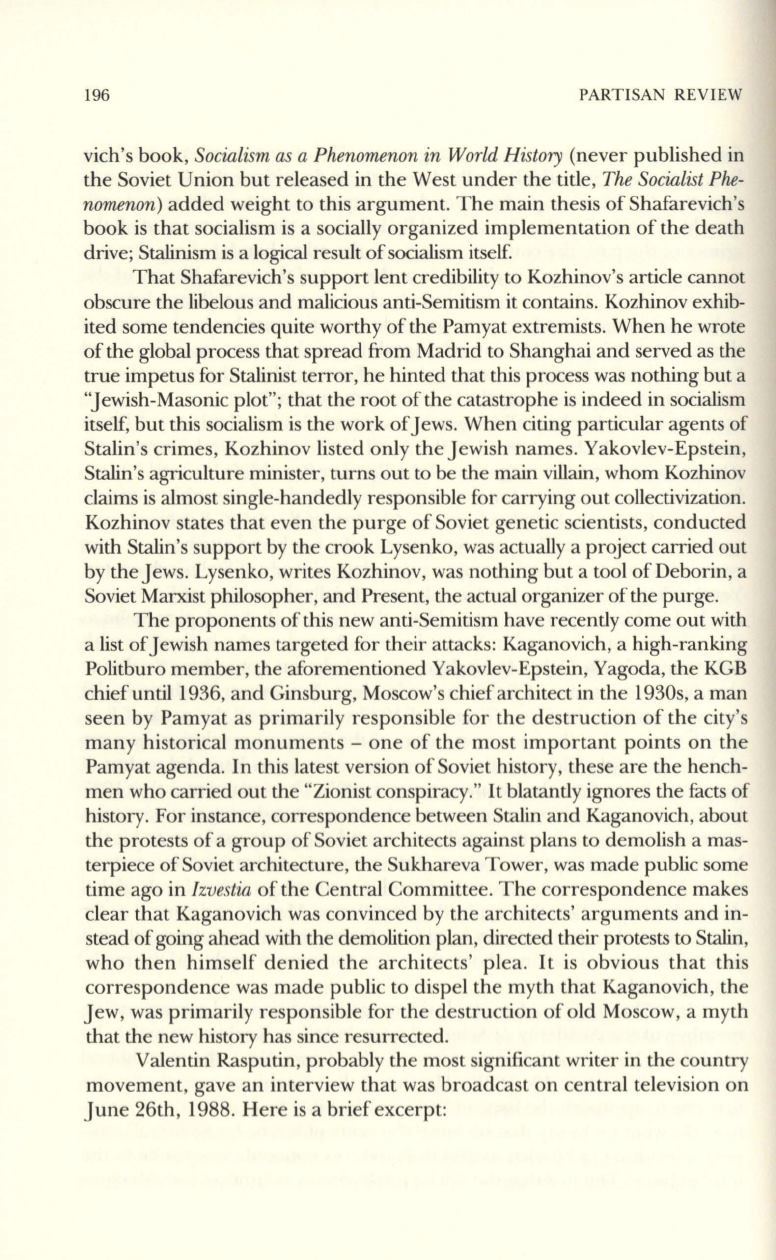
196
PARTISAN REVIEW
vich's book,
Socialism as a Phenomenon in World History
(never published in
the Soviet Union but released in the West under the title,
The Socialist Phe–
nomenon)
added weight to this argument. The main thesis of Shafarevich's
book is that socialism is a socially organized implementation of the death
drive; Stalinism is a logical result of socialism itself
That Shafarevich's support lent credibility to Kozhinov's article cannot
obscure the libelous and malicious anti-Semitism it contains. Kozhinov exhib–
ited some tendencies quite worthy of the Pamyat extremists. When he wrote
of the global process that spread from Madrid to Shanghai and served as the
true impetus for Stalinist terror, he hinted that this process was nothing but a
"Jewish-Masonic plot"; that the root of the catastrophe is indeed in socialism
itself, but this socialism is the work ofJews. When citing particular agents of
Stalin's crimes, Kozhinov listed only the Jewish names. Yakovlev-Epstein,
Stalin's agriculture minister, turns out to be the main villain, whom Kozhinov
claims is almost single-handedly responsible for carrying out collectivization.
Kozhinov states that even the purge of Soviet genetic scientists, conducted
with Stalin's support by the crook Lysenko, was actually a project carried out
by the Jews. Lysenko, writes Kozhinov, was nothing but a tool of Deborin, a
Soviet Marxist philosopher, and Present, the actual organizer of the purge.
The proponents of this new anti-Semitism have recently come out with
a list ofJewish names targeted for their attacks: Kaganovich, a high-ranking
Politburo member, the aforementioned Yakovlev-Epstein, Yagoda, the KGB
chief until 1936, and Ginsburg, Moscow's chief architect in the 1930s, a man
seen by Pamyat as primarily responsible for the destruction of the city's
many historical monuments - one of the most important points on the
Pamyat agenda. In this latest version of Soviet history, these are the hench–
men who carried out the "Zionist conspiracy."
It
blatantly ignores the facts of
history. For instance, correspondence between Stalin and Kaganovich, about
the protests of a group of Soviet architects against plans to demolish a mas–
terpiece of Soviet architecture, the Sukhareva Tower, was made public some
time ago in
Izvestia
of the Central Committee. The correspondence makes
clear that Kaganovich was convinced by the architects' arguments and in–
stead of going ahead with the demolition plan, directed their protests to Stalin,
who then himself denied the architects' plea. It is obvious that this
correspondence was made public to dispel the myth that Kaganovich, the
Jew, was primarily responsible for the destruction of old Moscow, a myth
that the new history has since resurrected.
Valentin Rasputin, probably the most significant writer in the country
movement, gave an interview that was broadcast on central television on
June 26th, 1988. Here is a brief excerpt:


